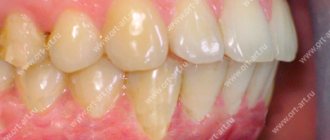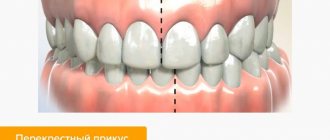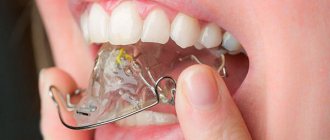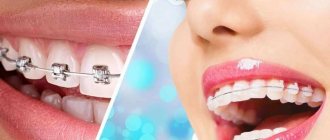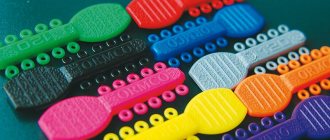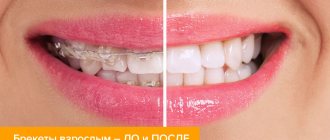To correct an abnormal bite, you can put braces on your teeth. Such orthodontic systems affect bone tissue, muscles and ligaments, and help slowly move teeth into the correct position. Many people are interested in the question: is it possible to put braces on one jaw? You will find the answer in this article.
In this article
- What are braces?
- Are braces placed on one jaw?
- Main indications for partial correction
- Orthodontic correction up to 12 years
- Braces for the lower jaw only for mild crowding
- Treatment for crowded upper anterior incisors
- Closing the gap between the front incisors
- Partial bracket system for preparation for prosthetics
- Absence of chewing teeth on the opposite jaw
- Should I install braces on one jaw or not?
What are braces?
A brace system is an orthodontic device that is installed on the teeth and helps them move in the desired direction. Structurally, this device consists of small plates (directly braces), which are glued to the dental crown at pre-calculated points, and a metal arch. This arc has shape memory and is an active element of the system. Fixed on the plates, it tries to regain its even position and thereby puts pressure on the teeth. As a result, their slow, gradual movement in the bone tissue occurs. Orthodontic treatment not only helps to correct the curvature of individual teeth in a row, it allows you to change the shape and position of the jaw, and restore facial symmetry.
It is preferable to begin orthodontic correction in childhood. But modern medical capabilities make it possible to carry it out even in adulthood and old age.
Most often, an orthodontic device is placed on two jaws at once. The dentist calculates in advance in which direction a particular tooth should move, how much it is necessary to expand the jaw or spread the dentition. Double-jaw treatment is comprehensive and allows you to solve global problems in occlusion correction. It usually takes from several months to several years.
Types of braces and their characteristics -
All types of braces can be classified according to several parameters, for example, by type of material and design features.
Bracket systems: types (table 1)
| By material type: | By type of construction: |
| 1. Metal | 1. Vestibular * |
| 2. Ceramic | 2. Lingual |
| 3. Ceramic with metal groove and/or lock | 3. Ligatures * |
| 4. Sapphire | 4. Unligated * (self-ligating) |
* The term “vestibular” means that the braces will be fixed on the vestibular (front) surface of the teeth - in contrast to lingual braces, which are fixed on the lingual surface of the teeth. Another important feature of brace systems is the type of fixation of the metal arch in the bracket groove - according to this, braces are divided into “ligature” and “non-ligature” (we will talk about why this is important in the next section).
Options for dental braces: photo
Are braces placed on one jaw?
Installing a brace system is one of the most common and effective methods for correcting an abnormal bite, improper closure of the teeth of the upper and lower jaw. Crooked teeth and abnormal jaw position not only spoil a person’s appearance, but also affect his health. Therefore, correcting the bite is important and necessary. But installing braces confuses many people.
Some are concerned about aesthetics, others are concerned about possible inconveniences when wearing the system, others simply want to save on orthodontic correction. And then the patient turns to the doctor with the following question: is it possible to install braces only on the upper jaw or only on the lower jaw.
As a rule, a person knows in advance which teeth he wants to change. And if they are located only on one jaw, then he expects that he will have a partial braces installed, only in the area of the curvature.
The doctor must make such a decision. It may seem to the patient that he has a problem only with the lower jaw, but the dentist sees during the examination that partial correction will not give an effective result. In this case, the orthodontist will insist on a complete correction. If you need a stable result of orthodontic treatment, we recommend listening to the professional opinion of an orthodontist.
Teeth hurt after braces tightening
We hasten to reassure you: this is natural and normal, because the pressure increases, and some discomfort, as at the very beginning, after installing braces, is inevitable. However, you should immediately tell your doctor about severe pain - constant discomfort that does not go away the next day after the tightening cannot be felt. You don’t have to endure it if the wire of the braces interferes with you and you touch it with your gums or tongue.
Dentist advice:
Before the braces tightening procedure, it is better to think through your diet in advance for a day or two in advance - exclude food that needs to be chewed vigorously and leave something simpler, soft food (yogurt, cereal, puree);- It is better to eat and brush your teeth before the procedure - afterward, due to the sensitivity of the teeth, it will be more difficult;
- Talk to your doctor about what type of pain medication you can take if the pain bothers you. Important: do not take painkillers or anti-inflammatory drugs on an empty stomach;
- After meals, you can (and even should) use an antibacterial mouth rinse.
Main indications for partial correction
In some cases, it is indeed possible to place braces on one jaw, and this approach will be effective. As a rule, these are situations where the teeth are only crooked at the top or bottom, but the bite is not broken and there is no facial asymmetry. Partial correction may be recommended for the following indications:
- one or two teeth are positioned incorrectly;
- slight crowding of teeth (lack of space - up to 3 mm);
- a gap between the front incisors in the absence of pathological closure of premolars and molars;
- correction of the position of teeth before installing dentures;
- the need to avoid sagging of the upper teeth when their antagonists (opposite units) in the lower jaw are absent.
Diagnostics will show how effective braces will be only on the upper jaw or, conversely, on the lower jaw. It should include a visual examination, x-rays, assessment of the condition of bone tissue and dental roots.
Let's consider cases when it is justified to place braces separately on the upper jaw and separately on the lower jaw.
At what age does it make sense for adults to get braces?
In any case, there are no age restrictions. There are surmountable obstacles: the general condition of the teeth, periodontal and gum diseases, and possible common concomitant diseases. Absolute contraindications for installing braces for adults coincide with many other types of treatment: lack of teeth, tuberculosis, diabetes, a number of immune diseases, epilepsy, bone pathologies, blood diseases. If a person gets braces when he is over thirty, the treatment will be quite long, since tissue regeneration occurs more slowly due to age. Plus, skeletal growth has already been completed, and the position of the bones can be “corrected” only when they are still growing - in childhood and adolescence. However, dentists achieve excellent results with mature patients.
Orthodontic correction up to 12 years
Braces are primarily used for children starting in their teens. This is due to the fact that by the age of 11-12 years the formation of the jaws is completed, and the primary bite is replaced by a permanent one. But often, an orthodontist discovers bite problems in a child at an earlier age. Installing partial braces helps solve some of them, as well as prepare teeth for further correction in adolescence.
The doctor can place an orthodontic device on one jaw or individual teeth in order to:
- create space for the eruption of permanent teeth;
- expand one of the jaws;
- close the gap between the front incisors (the so-called diastema);
- correct the incorrect position of one or more teeth that are bothering the child;
- preserve the space left after early removal of baby teeth, which neighboring ones are trying to occupy.
Thus, braces can be placed on one jaw at the age of 9-10 years to solve a specific orthodontic problem. In this case, in adolescence, further, already double-jaw, treatment will be required.
How to install the structure
Before using braces, you may need dental treatment for caries and other oral pathologies. After the orthodontic system is manufactured, it is installed on the teeth prepared for this. It happens like this:
- A bracket (clasp) is attached to each tooth and is fixed using a special adhesive composition.
- Each bracket is connected to the next archwire.
The features of this design make it possible to create a directed pressure of a certain force specifically on the curved teeth, which over time displaces or turns them in a given direction. The installation procedure does not cause any pain.
The duration of use of local braces depends on the type of pathology, its severity and the age characteristics of the patient, but most often it does not exceed ten months. Fragmentary braces can be placed on children when the baby incisors have been replaced by permanent ones, as well as when all the chewing teeth have grown, which is important for the quality of the system installation. That is, this is possible at the age of 8-10 years.
Braces for the lower jaw only for mild crowding
Crowding is the position of teeth when they are too close to each other. As a result, rotation, curvature, and “layering” of each other occur. If slight crowding is observed only on the lower front incisors, while the upper front incisors are positioned evenly and the lateral ones close correctly, in this case, braces are sometimes placed only on the lower jaw. An important condition for this method is that there must be enough space to move horizontally so that the teeth can take the correct position. This treatment method is chosen in cases where the lack of space for alignment is less than 3 mm. With this method, separation of the front incisors is almost always performed - that is, minor grinding of the contact surfaces, which allows you to free 0.25 mm from each surface and in total create those missing 1-3 mm for alignment in the dentition.
Self-regulating braces design reviews
From my own experience, I can say that for the majority of patients, adaptation is quick and painless. After getting used to it, there are no problems with cleaning and eating. All patients are satisfied with the results of the treatment, except for those cases when people think that they overpaid for the design and it was not worth the money. Regarding this, I can say one thing: all designs have their place in modern orthodontics, and choosing a budget design is not always the worst option. At the LeaderStom clinic, our specialists will advise you on any issue on this or any other topic, and will also give you back a beautiful smile.
Treatment for crowded upper anterior incisors
Braces on the upper jaw only can be placed if crowding is observed on the upper front incisors. The conditions are the same - the space deficit should be no more than 2-3 mm. In addition, treatment should not require expansion of the dentition. In this case, for orthodontic correction it is not necessary to involve the lower dentition.
If you provide space for uneven teeth by expanding the upper row, this will disrupt the closure. As a result, the teeth will “seek contact” with each other, the upper row will become narrow again, and in the long term the goal of orthodontic treatment will not be achieved. Therefore, if it is necessary to expand the upper row of teeth in order to correct crowding, a partial braces system cannot be used; a two-jaw apparatus will have to be installed. Braces can only be placed on the upper jaw if space for teeth is freed up using the separation method (their width is reduced by grinding the contact surfaces).
Diet and hygiene of orthodontic patients
Patients with metal and ceramic braces follow a diet and monitor oral hygiene. Orthodontists recommend eliminating sticky and hard foods: chips, nougat, chewing gum and toffees. Patients cut fruits, vegetables and meat into pieces. If a person does not follow a diet, the braces come off and treatment slows down.
Caring for teeth with braces becomes more complicated: patients use manual and single-beam toothbrushes, brushes and an irrigator to clean the enamel under the arch and around the braces. Teeth are brushed in the morning, in the evening and, if possible, after each meal. It is easier to care for metal self-ligating braces: the devices have few protruding elements in which food gets stuck. The low profile also contributes to better oral hygiene.
Closing the gap between the front incisors
Braces can be placed on the lower jaw if there is a large gap (diastema) between the lower front incisors. In this case, several conditions must be met:
- the lateral teeth close together normally;
- there is an opportunity for a “joint to joint” closure of the front teeth of the upper and lower rows.
If these conditions are not met, it may be necessary to artificially increase the size of those teeth between which there is a gap. This is done using filling material. If the patient is not ready to fill healthy teeth in order to increase their size, then single-jaw treatment of diastema will not suit him, since the doctor will not be able to guarantee the stability of the result.
Which braces are better: popular Ormco models
Here is a brief description of Ormco self-ligating and ligature metal bracket systems.
- Damon Q2 passive self-ligating braces went on sale in 2018. High-precision groove with improved rotation control, increased subligature space for elastic fixation and cap-mounted guides for precise positioning. Damon Q2 is compatible with Damon Q, Damon Clear2 and buccal tubes: the doctor flexibly uses the Damon ecosystem to achieve results. Damon Q2 – reliable metal braces with a high-precision groove.
benefits of Damon Q2
- Damon Q metal braces are Ormco's best seller. Since 2008, a million patients in Russia have been treated using this model. Small size and rounded edges do not rub the mucous membrane. The mesh base secures the braces to the tooth enamel throughout the entire treatment period. Damon Q is a confident choice for an orthodontist.
Damon Q Stainless Steel
- Mini Diamond is a system of metal ligature braces with a universal diamond shape. Using the properties of 17-4 steel and MIM casting technology, Ormco engineers reduced the size of the bracket by 30%. For the anterior and lateral groups of teeth, the doctor can choose zero, standard, low and high torque. Orthodontists fix the Mini Diamond in complex clinical cases that require small sizes and careful control of the position of the teeth. Mini Diamond is suitable for patients on a budget.
Mini Diamond in 17-4 steel
- Orthos – ligature metal braces. For five years, a team of researchers using computer engineering methods developed a design for orthodontists. The result of the work is a “smart” system of braces, arches and buccal tubes, as well as its own recipe. Features of the Orthos prescription are negative torque and progressive positive angulation of lower incisor brackets, reduced values of negative torque in the lateral regions and positive angulation of lower and upper second premolars.
ligature Orthos on typodont
- Titanium Orthos are classic ligature braces made of titanium alloy for patients with allergic reactions to nickel. Models of the anterior group of teeth with a curved shape repeat the surface of the incisors and canines: this makes it easier for the doctor to position the locks during fixation.
- Synthesis – ligature braces enlarged compared to Mini Diamond with precise rotational and angulation control of teeth on a straight arch. The model is suitable for budget treatment.
When comparing types of metal braces, Damon Q2 comes to the fore. The doctor does not waste time removing ligatures or trying to open jammed lock covers. Without making any effort, the orthodontist turns a special “key” and changes the arch without pain for the patient. Elastic chains and rods cling to the enlarged subligature space of the braces. Patients do not waste a single day on their way to a Hollywood smile.
Partial bracket system for preparation for prosthetics
Sometimes braces are placed on only one jaw in preparation for prosthetics or in order to close empty spaces from extracted teeth. In the first case, braces help change the angle of the teeth to make room for an implant or bridge. In the second case, the brace system is used to move the posterior chewing tooth to the place of the previously removed one, thereby closing the empty gap and avoiding prosthetics. It is important to note that such treatment is usually complex and lengthy (tooth movement can take up to four years).
The orthodontist decides how appropriate it is to install a partial brace system for such indications in each specific case.
Material of manufacture
In terms of material, there are braces made of metal, ceramic, plastic and combined models. The peculiarities of the manufacturing material, the complexity of the clinical case, aesthetic requirements and financial capabilities allow the doctor and the patient to jointly decide which bracket system is better. There are no universal recommendations.
Ligature systems are made from a metal alloy (Orthos, Mini Diamond) and transparent artificially grown sapphire (aesthetic Inspire ICE). Aesthetic ligature braces are superior in size to metal structures. The disadvantage is more complex activation and an increased period of patient adaptation to foreign structures.
aesthetic sapphire Inspire ICE
Non-ligature structures are made of metal (Damon Q, Damon 3MX) and especially durable ceramics (Damon Clear 2). The adaptation period is easier than when installing devices with ligatures. Treatment with Damon systems is reduced by an average of 7 months compared to treatment with ligature braces.
teens with Damon Q braces
If psychological comfort or the characteristics of an adult patient’s profession require an inconspicuous system, it is advisable to choose Inspire ICE sapphire braces or Damon Clear 2 ceramic braces. For a child, sapphire and ceramic structures are not always a good choice due to increased fragility: a teenager can accidentally damage the elements of the system as a result injury or poor diet.
transparent Inspire ICE on typodont
Should I install braces on one jaw or not?
If the patient is concerned about the question of whether braces are placed on the lower jaw, then the answer will be positive. An orthodontic device can be installed not only on the lower or upper jaw, but also on individual teeth or areas of the dentition. But the main question is whether such treatment would be advisable. As a rule, installing a brace system on one jaw solves exclusively local dental problems. This process is more difficult to control and provides fewer treatment options. If contraindications are not provided, even a successful result will be short-lived, and the teeth will return to their previous position.
Thus, a dentist planning single-jaw orthodontic treatment must carefully assess the risks, take into account the many factors that will influence tooth movement and predict in advance the effectiveness and stability of the result.
If the doctor sees that solving the problem with a partial braces system will be problematic, he will recommend double-jaw treatment to the patient. Its advantages are that teeth can move in different planes without negative effects such as disruption of contacts between the upper and lower ones. Plus, such treatment is easier to predict and control, and it gives a more sustainable result.
Additional methods and alternatives to braces treatment
A number of patients do not tolerate wearing braces well. Therefore, modern orthodontics invents and offers alternative treatment methods for use. Deviations from the norm when closing the teeth are insignificant; local irregularities in the dentition are perfectly corrected by aligners and elastopositioners. These are modern orthodontic devices in the form of a mouth guard made of absolutely harmless and bioinert material. They can be removed, they are transparent, do not change color when worn and do not absorb foreign odors, they are easy to care for.
The aligner is used to get rid of various types of abnormal bites. An elastopositioner is a multifunctional device in orthodontics, used to stimulate the growth of the lower jaw, wean children from bad habits, or if the child has mouth breathing.
And also for snoring or to consolidate the results of treatment as a retention structure. Only a doctor can determine which system or device is suitable in each specific case. The choice of braces or their alternative depends on the diagnosis and degree of pathology, as well as the individual preferences of the patient.
Price of braces for adults in Moscow
To avoid misleading you, we will not indicate specific amounts. Because orthodontic treatment for adults is time-consuming and often requires additional or preparatory procedures, its overall cost cannot be low. But the opportunity to smile broadly without embarrassment is priceless at any age! Therefore, it makes sense to schedule a consultation with an orthodontist, no matter how old you are. After examination and research, the doctor will tell you the exact cost of treatment in your case.
Retainers: why are they worn after braces are removed?
A retainer is a device that looks like an arch. It is placed on the back surface of the teeth when braces are removed. This way the new position of the teeth is secured. The ligamentous apparatus of the teeth has muscle memory, so no matter how we move the teeth, they will tend to return to their “original” position. Wearing a retainer is an essential part of orthodontic treatment. This is especially true for people over twenty-five years of age. A retainer is installed for at least two periods of wearing braces: for example, the patient wore them for one year, then the retainer will need to be worn for two years. Foreign orthodontists generally argue that you need to wear retainers constantly - this is the only way to guarantee that your teeth will remain straight. In general, after some time the retainer can be replaced with a night guard or plate. But some kind of structure supporting the new position of the teeth will definitely be needed - this is a classic. Unfortunately, patients often neglect this stage of treatment, experience relapses and begin to talk about the ineffectiveness and uselessness of orthodontic treatment in adulthood.




